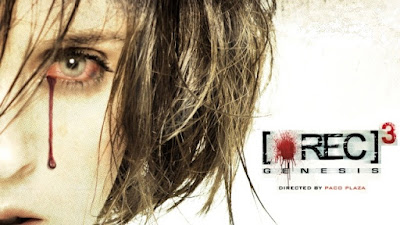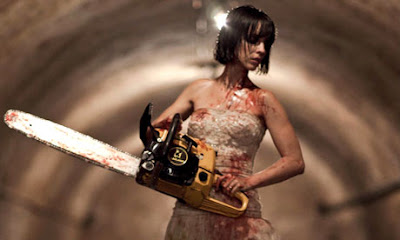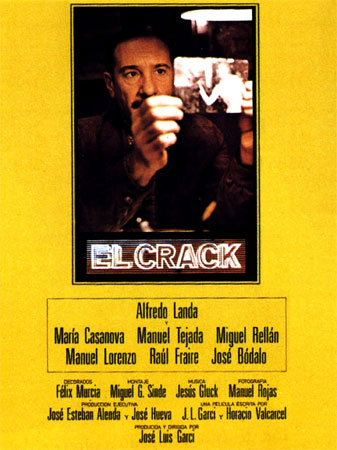Spanish
[REC]3 Génesis

I arrived at this film with high hopes. The first [REC] is a film I absolutely love. Studying Spanish and being mad-keen on zombie films, it seemed almost too good to be true that one of the twenty-first century’s best zombie films was filmed by two Spanish directors in an appartment block in Barcelona. It’s a powerful, scary zombie film (that staircase death!) that managed to breath new life into both the zombie and the found-footage genres. Impressive stuff.
The second in the series was by no means as good but it was still streets ahead of most of the competition. Balaguero and Plaza played around with the restrictions of the found-footage film, spiced up the zombies with a bit more religion (not to everyone’s taste) and spent their obviously increased budget on quantities of guns and gore. More impressive stuff.
Coming to the third instalment, then, my hopes were high. Almost worryingly high. I’m pretty sure that at some point Balaguero and Plaza had said they intended to stop after the second but, given its commercial success, rights-holders Filmmax said they’d continue with other directors in that case (I might have imagined this. But I think it happened). Whatever the details of the scenario, B+P did sign up to do more [REC] films but planned two more, of which they would direct one each, rather than co-directing as before. [REC]3 is Plaza’s segment. It takes place, as far as I can tell, at roughly the same time as the first film. What seemed like an isolated outbreak clearly wasn’t…

It opens in the now-familiar shaky-camera style. We’re at the wedding of Koldo and Clara. As the family and friends move on to the reception, however, it emerges that the Uncle’s dog-bite may be infected. Badly. Coughing blood and staggering, there are no prizes for guessing what happens next. It is, essentially, all fairly predictable. We’re ushered into a secure location (country house), introduced to the characters/victims (wedding guests) and then a zombie is thrown into the mix and all hell breaks loose.
That said, [REC]3 handles it all pretty well. The country house makes a refreshing change from the apartment block of before, the characters are (mostly) intelligent and likeable and, most crucially of all, the gore is good. Some cruel, splattery deaths are dealt to zombies and humans alike, characters are killed off, heads and limbs are hacked at. It’s gleeful, bloody stuff (which is exactly what we want, right?)
It’s certainly not as innovative or as well-crafted as the first film, I’ll accept that, but I’d say that it gave [REC]2 a pretty close run. [REC]3 is a well-made, straight-faced, zombie-movie. And I enjoyed it a lot.

El Crack

When you think of film noir, you think of it’s true home - America. We think of corrupt cops, mean streets, whisky on the breath of hard-working loner detectives and screeching tyres through the city.
As you turn towards the 70s, the real Noir has long ceased to be and is now replaced by the neo-noir. The relationship between these films and the original classic Hollywood output is confusing and often contradictory. They are at once parodies of classic noir, re-imaginings of the genre and cinematic love-letters to a genre left behind.
This brings all sorts of other concerns; unless they go to the extent of setting themselves within the time period of the classic noir, contemporary issues become involved, the world had changed between the 40s and 70s and so the hard-boiled detective story had to as well. Similarly, if we move the narrative away from America, the different geography brings it’s own tensions, styles and attitudes. The final product is, in many respects, a million miles away from the film noir, yet somehow remains linked.
In real terms, films like El Crack (Spain, 1981) are as far removed from true noir as American teen slashers of the 90s are from Italian giallo thrillers. Only a few core elements are left to connect the two genres yet somehow you can’t help but see a link.
In making El Crack, they certainly intended the link to be visible; from the opening dedication to Dashiell Hammett to the corruption, gunshots and nighttime city, this is both desperately seeking comparisons to American noir and making a statement of Spanish independence. It is both derivative and original. It’s also pretty good fun.


Alfredo Landa plays the central detective, Germán, excellently. It is his performance that both links and distances this from the American noir. He is an ex-cop, a workaholic detective who is too honest and honourable for his own good. He passionately works late into the night on his case - a missing girl - fuelled by coffee, cigarettes and (asserting the Spanish-ness) the odd calamari sandwhich.
The other characters are mostly ‘by-numbers’ hard-boiled characters; Germán has a slimy ex-thief assistant and lives in a world populated by crooked cops and businessmen who think themselves above the law. Where it branches far from Noir however, is Germán’s love interest. I don’t know whether it came about as a result of Spanish Catholiscism, a deep-routed belief in the family unit or whatever else but, rather than the femme-fatal of the American noir, charged with sex and danger, Germán is pursuing a relationship with a pretty but conservative nurse. It’s all very civilised; he picks up her daughter from school while she works, they go for strolls in the woods or off to see a film. It’s all very… nice.
These niceties only serve to make the brutality of the last third of the film more brutal. Germán may be a much milder man than the creations of Chandler or Hammett, but when he’s pushed he acts surprisingly coldly in pursuit of justice.
The only real criticism of the film is that the pacing is a bit awkward. European films do tend to be a lot slower than American films; we seem to prefer slow build rather than a rollercoaster of climactic moments, but this one is decidedly on the slow side of ‘slow-build’. The first half and hour to forty minutes do drag somewhat but, I promise you, it’s worth persevering as the film builds slowly but surely towards a thrilling ending.

